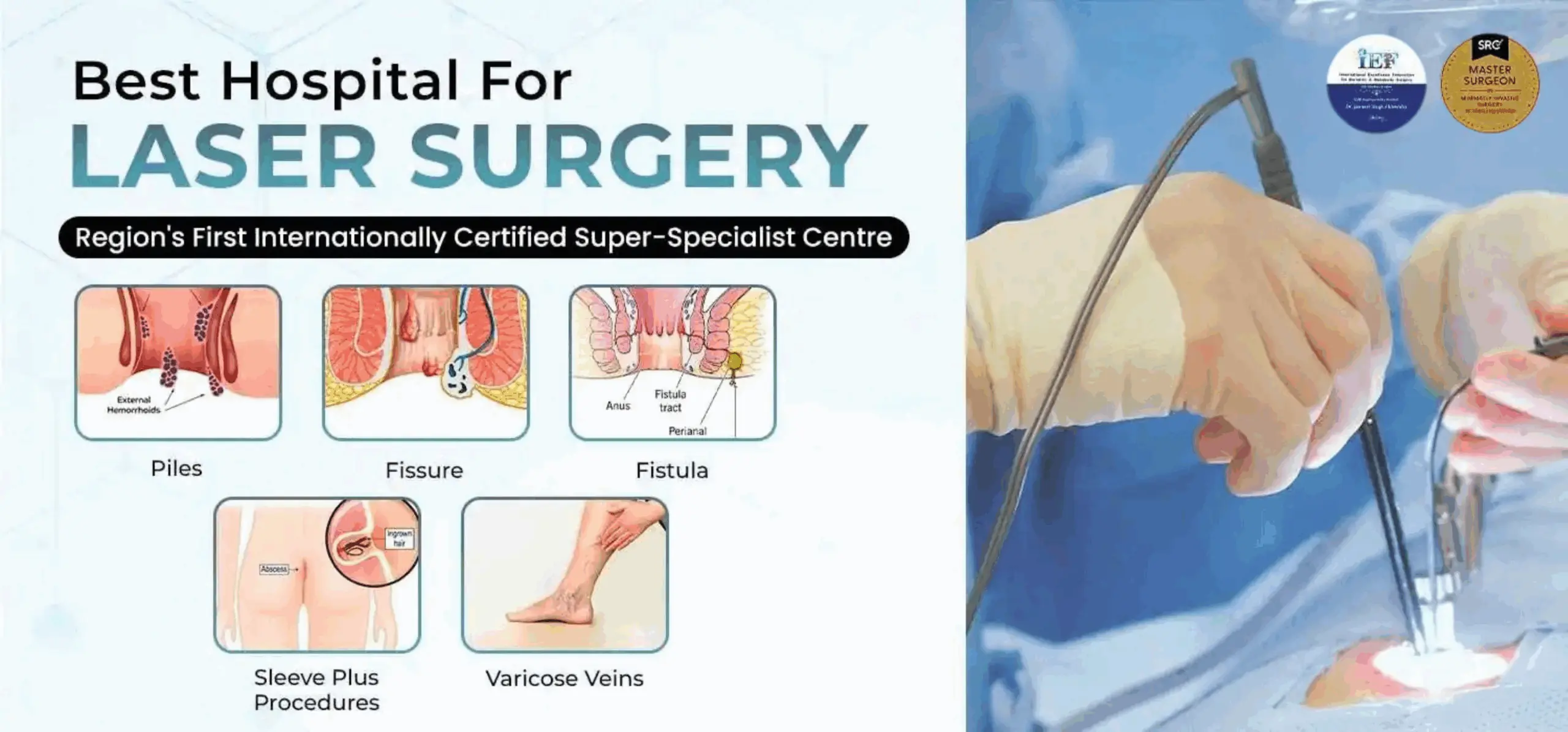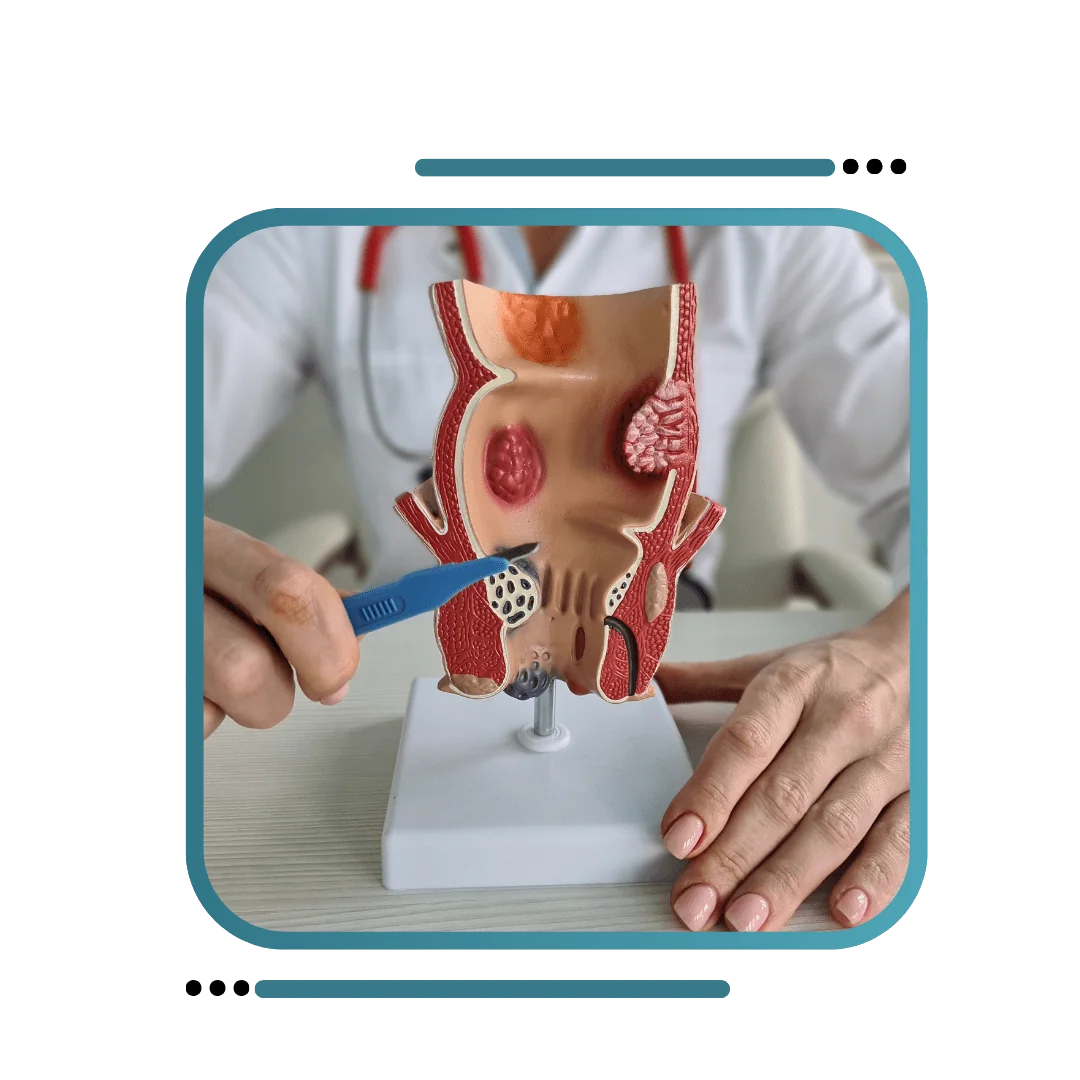
Fissure Surgery in Jalandhar
If you are tired of the Ano-rectal issues then Fissure Laser Surgery In Jalandhar, Punjab is now available. We’re a specialist in the treatment of piles during the Fissure laser surgery. In some cases, Endoscopy is better evaluation of your symptoms. So Our doctor examines you and according to your issues, they can tell about your treatment. Anal fissure is a small tear in the superficial part of anal canal and cause pain and bleeding with bowel movements. Most anal fissures respond to simple treatments but some will require surgery.

Symptoms
Signs and symptoms of an anal fissure include:
- Pain, mild to severe after passage of stools and may last for hours after that
- Bright red blood on the stool or toilet paper
- Skin tag on anal verge
Causes
Common causes of anal fissure include:
- Hard stools
- Constipation and straining during bowel movements
- Chronic diarrhea
- Pregnancy
- Childbirth
Neat & Clean Rooms
Spotlessly clean, profoundly caring. Our hospital ensures a pristine environment for your well-being
Modern Equiments
Our hospital has advanced technology gadgets and the best equipment in every field.
City Centre Location
Conveniently located at the heart of the city, our hospital offers easy access and exceptional care in a prime city center location

Complications
- Complications of anal fissure can include:
- Failure to heal:- An anal fissure that fails to heal within eight weeks is considered chronic and may need further treatment.
- Once you’ve experienced an anal fissure, you are prone to having another one.
- A tear that extends to surrounding muscles.
- Prevention
- High-fiber diet
- Drink more fluids
- Exercise regularly
Diagnosis
- Usually simple examination by doctor will be enough to diagnose fissure.
- An anoscope is a tubular device inserted into the anus to help your doctor visualize the rectum and anus.
Treatment Anal fissures often heal within a few weeks if you take steps to keep your stool soft, such as increasing your intake of fiber and fluids. Soaking in warm water for 10 to 20 minutes several times a day, especially after bowel movements, can help relax the sphincter and promote healing. If your symptoms persist, you’ll likely need further treatment.
Nonsurgical treatments
Doctor will usually try medicines and life style modifications to relieve symptoms but if they do not work, surgery may be needed.
Surgery
Lateral Internal Sphincterotomy- (LIS) involves cutting a small portion of the anal sphincter muscle to reduce spasm and pain, and promote healing. Studies have found that for chronic fissure, surgery is much more effective than any medical treatment.
Fistula surgery In Jalandhar
Fistula Surgery In Jalandhar, Our Doctors handle a large number of Fistula Surgery Cases. he has successfully cured all the cases. Fistula is a small channel that develops around the anus. Fistula has two openings- Internal into the rectum and External Through the skin. They Diagnosis according to your problems and symptoms. The doctors our specialist in this field so contact us if you have any query for this problem.
Anal fistula is the medical term for an infected tunnel that develops between the skin and the anal canal Most anal fistulas are the result of an infection that starts in an anal gland. This infection results in collection of pus near anal opening that drains through the skin next to the anus. The fistula then forms a tunnel under the skin and connects with the infected gland. Surgery is usually needed to treat anal fistula as even after medical therapy, infection persists in fistula tract and it does not heal completely.
Treatment
Treatment of anal fistula depends on the fistula’s location and complexity. The goals are to repair the anal fistula completely to prevent recurrence and to protect the sphincter muscles. Damage to these muscles can lead to fecal incontinence. The options include:
- The surgeon cuts the fistula’s internal opening, scrapes and flushes out the infected tissue.
- Advancement rectal flap.The surgeon creates a flap from the rectal wall before removing the fistula’s internal opening. The flap is then used to cover the repair. This procedure can reduce the amount of sphincter muscle that is cut.
- Seton placement.The surgeon places a silk or latex string (seton) into the fistula to help drain the infection. This is usually done for higher fistula.
- Ligation of the intersphincteric fistula tract (LIFT).A seton is first placed into the fistula tract, forcing it to widen over time. Several weeks later, the surgeon removes infected tissue and closes the internal fistula opening.
- Video-Assisted Anal Fistula Treatment (VAAFT) – This involves visualization of fistula tract using a video scope and tract is then coagulated with electric current or laser.
- In cases of complex fistula, more-invasive procedures may be recommended, including:
- Ostomy and stoma.The surgeon creates a temporary opening in the abdomen to divert waste into a collection bag, to allow the anal area time to heal.
- Muscle flap.In very complex anal fistulas, the channel may be filled with healthy muscle tissue from the thigh, labia or buttock.
Fissure Surgery Patients Testimonials
EXCELLENTTrustindex verifies that the original source of the review is Google. Thank you doctor Mandeep Kaur. I had a Positive result after 2 weeks of my IUI I am so happy I was waiting for so long to concive and to see 2 lines on my pregnancy test but every time that was unsuccessful but this was my first try with IUI and that’s go successfully thank you so much. 😊😊Posted onTrustindex verifies that the original source of the review is Google. Great experience with Dr. Mandeep and staff of the hospital.Posted onTrustindex verifies that the original source of the review is Google. My experience is very goodPosted onTrustindex verifies that the original source of the review is Google. Great Staff With good facilitiesPosted onTrustindex verifies that the original source of the review is Google. Thank you so much Dr mandeep from the bottom of hearts for taking such good care. Because of your professionalism and great smiles, we felt like we were in good hands and that gave us peace of mind towards the big day.Posted onTrustindex verifies that the original source of the review is Google. I got my friend’s weight loss surgery done at Star Hospital. We were impressed by Dr Ahluwalia’s clarity of thought on weight loss and Bariatric Surgery. We visited some other hospitals before and were always confused as their versions were very different but here we got answers to all our questions in a very clear way and my friend could gather courage to finally get his Bariatric Surgery done and start living a normal life again. Procedure went smooth as was told and we were out out of hospital very next day. Now we regret delaying this for years!Posted onTrustindex verifies that the original source of the review is Google. Dr Mandeep is a very hardworking and nice doctor.my result came positive and I'm very thankful to mam and all the staff members 🙏🙏










